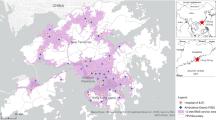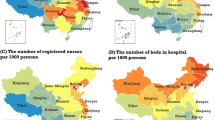Abstract
According to previous research, the most important factor for patient’s survival is based on the emergency treatment in the ambulance and the effective allocation of emergency resource when emergency patients experience out-of-hospital cardiac arrest (OHCA) before arriving the hospital. This study intended to combine the regional information of emergency medical resources and the data base of geographic information for ambulance to assess the best method of medical treatment for OHCA patients, such as the closest medical center, the level of first-aid capabilities, the proper medical department, the information for hospital beds and the special need for medical section, so that EMD can make decision based on these suggestions. For providing the strategy of emergency ambulance, this research proposed the impact of the optimized population, the level of regional development, the allocation of emergency medical resource, the best timing of executing the chain of survival and the advanced cardiac life support, on the survival rate of OHCA patients through big data analysis. Or through increasing the spatial allocation and flexibility of EMT-P, it can reflect the importance of spatial factors in the challenge for the allocation of emergency medical resources. The results of this study can provide the recommendations for the policy of medical resource allocation.













Similar content being viewed by others
References
Syue Y-J, Yen Y-L, Cheng S-Y, Hung C-W, Wu K-H, Lin Y-R (2015) Characteristics and risk factors of out-of-hospital cardiac arrest within 72 hours after discharge. Am J Med Sci 350(4):272–278
Markusohn E et al (2007) Primary percutaneous coronary intervention after out-of-hospital cardiac arrest: patients and outcomes. Hypertension 12:48
Hoeijen DAV, Blom MT, Bardai A, Souverein PC, Boer AD, Tan HL (2014) Reduced prehospital survival rate after out-of-hospital cardiac arrest in patients with diabetes mellitus type 2: a prospective community-based study. Circulation 130:A246–A246
Davies H, Loosely A, Dolling S, Eve R (2014) Predicting survival in patients admitted to intensive care following out-of-hospital cardiac arrest using the prognosis after resuscitation score. Crit Care 18(Suppl 1):491
Maupain C et al (2015) The CAHP (Cardiac Arrest Hospital Prognosis) score: a tool for risk stratification after out-of-hospital cardiac arrest. Eur Heart J 37:3222
van Genderen ME, Lima A, Akkerhuis M, Bakker J, van Bommel J (2012) Persistent peripheral and microcirculatory perfusion alterations after out-of-hospital cardiac arrest are associated with poor survival. Crit Care Med 40(8):2287–2294
Sasson C, Rogers MA, Dahl J, Kellermann AL (2010) Predictors of survival from out-of-hospital cardiac arrest a systematic review and meta-analysis. Circ Cardiovasc Qual Outcomes 3(1):63–81
R. O. C. T. Ministry of Health and Welfare (2018) The Cause of Death Statistics. http://www.mohw.gov.tw/cht/DOS/Statistic.aspx?f_list_no=312. Accessed 10 Feb 2018
Valenzuela TD, Roe DJ, Cretin S, Spaite DW, Larsen MP (1997) Estimating effectiveness of cardiac arrest interventions a logistic regression survival model. Circulation 96(10):3308–3313
Sasson C et al (2010) Small area variations in out-of-hospital cardiac arrest: does the neighborhood matter? Annals Intern Med 153(1):19–22
Root ED, Gonzales L, Persse DE, Hinchey PR, McNally B, Sasson C (2013) A tale of two cities: the role of neighborhood socioeconomic status in spatial clustering of bystander CPR in Austin and Houston. Resuscitation 84(6):752–759
Sasson C et al (2013) Increasing cardiopulmonary resuscitation provision in communities with low bystander cardiopulmonary resuscitation rates a science advisory from the American Heart Association for Healthcare Providers, Policymakers, Public Health Departments, and Community Leaders. Circulation 127(12):1342–1350
Kulldorff M (1997) A spatial scan statistic. Commun Stat Theory Methods 26(6):1481–1496
Waller LA, Gotway CA (2004) Applied spatial statistics for public health data. Wiley, London
Anselin L (1995) Local indicators of spatial association—LISA. Geogr Anal 27(2):93–115
Nassel AF et al (2014) Multiple cluster analysis for the identification of high-risk census tracts for out-of-hospital cardiac arrest (OHCA) in Denver, Colorado. Resuscitation 85(12):1667–1673
Silverman BW (1986) Density estimation for statistics and data analysis. CRC Press, Boca Raton
Oyang Y-J, Hwang S-C, Ou Y-Y, Chen C-Y, Chen Z-W (2005) Data classification with radial basis function networks based on a novel kernel density estimation algorithm. IEEE Trans Neural Netw 16(1):225–236
Oyang Y-J, Ou Y-Y, Hwang S-C, Chen C-Y, Chang DTH (2005) Data classification with a relaxed model of variable kernel density estimation. In: Proceedings of the 2005 IEEE International Joint Conference on Neural Networks, IJCNN’05, vol 5, pp 2831–2836. IEEE
Kanuganti S, Sarkar A, Singh AP (2016) Quantifying accessibility to health care using two-step floating catchment area method (2SFCA): a case study in Rajasthan. Transp Res Proc 17:391–399
Fujita M, Sato Y, Nagashima K, Takahashi S, Hata A (2017) Impact of geographic accessibility on utilization of the annual health check-ups by income level in Japan: a multilevel analysis. PLoS ONE 12(5):e0177091
Luo W, Wang F (2003) Measures of spatial accessibility to health care in a GIS environment: synthesis and a case study in the Chicago region. Environ Plan B Plan Des 30(6):865–884
Lee HJ, Ju YJ, Park E-C (2016) Positive correlation between regional emergency medical resources and mortality in severely injured patients: results from the Korean National Hospital Discharge In-depth Survey. Can J Emerg Med 19:450
Schechtman D, He JC, Zosa BM, Allen D, Claridge JA (2017) Trauma system regionalization improves mortality in patients requiring trauma laparotomy. J Trauma Acute Care Surg 82(1):58–64
Tansley G et al (2017) Development of a model to quantify the accessibility of a Canadian trauma system. Can J Emerg Med 19:285
Hazinski MF, Field JM (2010) 2010 American Heart Association guidelines for cardiopulmonary resuscitation and emergency cardiovascular care science. Circulation 122(Suppl):S639–S946
Shieh J et al (2017) Big data analysis of emergency medical service applied to determine the survival rate effective factors and predict the ambulance time variables. http://www.worldresearchlibrary.org/up_proc/pdf/649-148758236551-56.pdf. Accessed 10 Feb 2018
Swalehe M, Aktas SG (2016) Dynamic ambulance deployment to reduce ambulance response times using geographic information systems: a case study of Odunpazari District of Eskisehir Province, Turkey. Proc Environ Sci 36:199–206
Alnemer K et al (2016) Ambulance response time to cardiac emergencies in Riyadh. Imam J Appl Sci 1(1):33
Fransen K, Neutens T, De Maeyer P, Deruyter G (2015) A commuter-based two-step floating catchment area method for measuring spatial accessibility of daycare centers. Health Place 32:65–73
Xu L, Kwan M-P, McLafferty S, Wang S (2017) Predicting demand for 311 non-emergency municipal services: an adaptive space-time kernel approach. Appl Geogr 89:133–141
Sanson G et al (2016) Emergency medical service treated out-of-hospital cardiac arrest: identification of weak links in the chain-of-survival through an epidemiological study. Eur J Cardiovasc Nurs 15(5):328–336
Park JH, Ro YS, Do Shin S, Song KJ, Hong KJ, Kong SY (2018) Dispatcher-assisted bystander cardiopulmonary resuscitation in rural and urban areas and survival outcomes after out-of-hospital cardiac arrest. Resuscitation 125:1–7
Masterson S, Teljeur C, Cullinan J, Murphy AW, Deasy C, Vellinga A (2017) The effect of rurality on out of hospital cardiac arrest resuscitation incidence: an exploratory study of a National Registry Utilizing a Categorical Approach. J Rural Health. https://onlinelibrary.wiley.com/toc/17480361/0/0. Accessed 10 Feb 2018
Uber A, Sadler RC, Chassee T, Reynolds JC (2017) Bystander cardiopulmonary resuscitation is clustered and associated with neighborhood socioeconomic characteristics: a geospatial analysis of Kent County, Michigan. Acad Emerg Med 24(8):930–939
Henriksen FL, Schorling P, Hansen B, Schakow H, Larsen ML (2016) First AED emergency dispatch, global positioning of community first responders with distinct roles-a solution to reduce the response times and ensuring an AED to early defibrillation in the rural area Langeland. Int J Netw Virtual Organ 16(1):86–102
Author information
Authors and Affiliations
Corresponding author
Rights and permissions
About this article
Cite this article
Kao, JH., Hsiao, PH., Oyang, YJ. et al. The study for dispatch decision of medical emergency resources with real-time spatial analysis. J Supercomput 76, 1604–1627 (2020). https://doi.org/10.1007/s11227-018-2358-x
Published:
Issue Date:
DOI: https://doi.org/10.1007/s11227-018-2358-x




